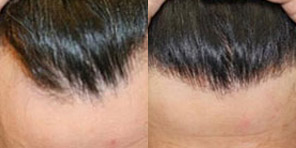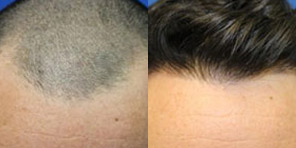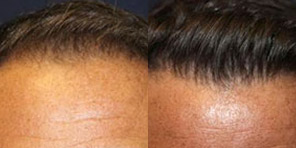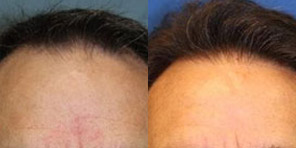SmartGraft
Consultations offered at our four convenient locations in La Jolla, San Diego, Newport Beach and Beverly Hills
Contents
- 1 Precise Hair Restoration
- 2 About SmartGraft
- 3 Benefits
- 4 Who is a Candidate for SmartGraft?
- 5 Personal Consultation
- 6 Preparing for SmartGraft
- 7 Procedure
- 8 What Does Recovery After SmartGraft Look Like?
- 9 What are the Results of SmartGraft Hair Restoration?
- 10 What is the Cost of SmartGraft in Beverly Hills?
- 11 References
Precise Hair Restoration

SmartGraft is a hair transplantation technique that uses a device to harvest and transplant hair follicles. It is a minimally invasive procedure designed to provide natural-looking results with minimal scarring. Hair loss can be a devastating blow to the ego of even the most confident among us. But with SmartGraft, patients can enjoy thick, lustrous hair with a restored hairline and confidence. The SmartGraft device mechanically removes individual hair follicles from the donor area (usually the back of the head) during the procedure. The hair follicles are then transplanted to the recipient area (where the hair is thinning or missing).
Interestingly, the SmartGraft device was actually developed by engineers who created the Neograft device and is based upon the same principles. The devices are quite similar.
Dr. Richard Chaffoo, a triple board-certified plastic surgeon, is California Hair MD’s founder and surgical director. With his extensive training and expertise, the center has gained a reputation as a leading facility for hair transplantation and restoration in California and beyond. Dr. Chaffoo is proud to offer this cutting-edge technology to his patients to help ease the frustrations of hair loss and bring back the ability to enjoy life thoroughly. If you are experiencing hair loss or feel you are already on that unfortunate path, change the course of your journey. Call our offices in La Jolla (858) 623-0221; Newport Beach (949) 612-2002; San Diego (619) 633-3100; or Beverly Hills (310) 595-1188. You can also fill out this form, and we will be in touch shortly.
Interested in all-things hair restoration? Check out our blog!
About SmartGraft
The traditional method of hair transplantation was the strip method, also known as follicular unit transplantation (FUT). This procedure involves the removal of a strip of skin from the donor area, usually the back of the head. The strip is then painstakingly dissected under a microscope to extract the individual hair follicles; they are then transplanted to the recipient area. The process was time-consuming and hard on the patient and surgeon.
There are several drawbacks to the strip method of hair transplantation:
- Removing a strip of skin from the donor area can leave a linear scar, which may be visible if the hair is worn short or if the scarring is extensive.
- The strip method may result in a longer recovery than other hair transplantation techniques, like SmartGraft.
- The strip method can only harvest a limited amount of hair from the donor area, which may need to be increased for more extensive hair transplantation procedures.
Thankfully, there are now practical and straightforward devices that make hair transplants easy and fast for the patient and the doctors who complete them. The new, award-winning SmartGraft system for hair restoration gives men and women a way to grow new hair without the drawbacks associated with the strip method technique.
What Conditions Can SmartGraft Address?
Some of the hair loss conditions that may be treated with the SmartGraft procedure include:
- Male pattern baldness is the most common cause of hair loss in men and is characterized by a receding hairline and thinning of the hair on the top and crown of the head.
- Female pattern baldness is characterized by thinning of the hair on the top of the head and along the hairline.
- Traction alopecia hair loss is caused by tight hairstyles, such as braids or ponytails, that pull on the hair and damage the hair follicles. [1]
- Alopecia areata is an autoimmune disorder that causes hair loss in patches on the scalp and other body areas. Alopecia areata is a hair loss condition that affects approximately 2% of the general population at some point during their lifetime. [2] It can occur at any age and can affect both men and women. Alopecia areata is not contagious and is not caused by a person’s diet or lifestyle. The cause of the condition is not fully understood, but it is thought to be related to a combination of genetic and environmental factors.
- Scarring alopecia is scarring on the scalp, which various factors, including trauma, burns, or certain medical conditions, can cause. [3]
The effectiveness of the SmartGraft procedure may vary depending on the cause and severity of the hair loss. Schedule your complimentary consultation at our La Jolla, Newport Beach, San Diego, or Beverly Hills, CA, locations to determine the specifics of your procedure. To learn more about hair restoration with SmartGraft, read on!
Benefits
Today’s hair grafting technology has revolutionized previous hair transplant methods, such as the strip method. With SmartGraft, surgeons can quickly access a large number of transplanted grafts in every session because the grafts are obtained from the entire donor area and not a concentrated area, as is the case with the strip method.
Further benefits of SmartGraft include:
- Permanent results
- An easier and shorter recovery period
- Less discomfort
- No linear scarring in the harvesting location
- Patients can often get short haircuts after the procedure.
One of the main advantages of SmartGraft is that it allows the surgeon to extract and transplant a large number of hair follicles in a single session, resulting in a more efficient and cost-effective procedure. It is also less traumatic for the patient and less exhausting for the surgeon. Call us today to learn more about the benefits of SmartGraft and have your questions answered by a triple-board-certified surgeon!
Who is a Candidate for SmartGraft?
If your expectations are realistic, we encourage you to inquire about this incredible new technology performed at the skilled hands of Dr. Chaffoo.
In general, good candidates for the SmartGraft procedure may have the following characteristics:
- Good overall health: Candidates should be in good overall health to withstand the demands of a five-hour procedure and resulting recovery.
- Stable hair loss pattern: The SmartGraft procedure is most effective for individuals with a stable hair loss pattern. If the hair loss is progressive or is due to an underlying medical condition, the procedure may not be as effective. Dr. Chaffoo can recommend alternative methods of restoration if this is the case.
- Sufficient donor hair: The SmartGraft procedure requires a sufficient supply of hair in the donor area to harvest and transplant. Candidates with a limited supply of donor hair may not be suitable for the procedure.
- Realistic expectations: Candidates must have realistic expectations about the procedure’s outcome. The SmartGraft procedure can restore a natural-looking head of hair, but it may not be able to restore the same density and fullness as before the hair loss occurred.
Personal Consultation
The consultation for a SmartGraft procedure is an opportunity for you to discuss your hair loss concerns and treatment options in a comfortable, supportive, and confidential environment. During the consultation, Dr. Chaffoo will ask about your medical history, hair loss pattern, and treatment goals. He will physically examine your scalp and take photographs for medical records.
Dr. Chaffoo will discuss the details of your treatment, including the expected outcome, the recovery process, and any potential risks and complications. He will also provide information on the cost of the procedure and any financing options that may be available.
At California Hair MD, we offer a wide array of hair restoration solutions, and we pride ourselves on finding the perfect one for each patient. Hair loss is not a one-size-fits-all problem, nor is restoration a one-size-fits-all solution. Call (619) 633-3100 to learn more.
Preparing for SmartGraft
Here is a brief overview; we will provide you with a complete list before the date of surgery.
- Stop taking certain medications such as blood thinners before the procedure.
- Maintaining a healthy lifestyle before the procedure can help improve the outcome and reduce the risk of complications. This may include eating a healthy diet, getting enough rest, and avoiding smoking and alcohol consumption.
- You may need to arrange transportation to and from the procedure, as you may be unable to drive yourself after the procedure. It is also a good idea to have someone available to assist with post-procedure care if necessary.
Procedure
Dr. Chaffoo will work with you to determine the implant and donor areas for the procedure; both locations will be identified before the day of surgery. The process takes around five hours, so it’s best to plan your appointment for the morning. The procedure may take more time, depending on the number of grafts needed.
You may be given a sedative to relax during the process. If you are given a sedative, you’ll need someone you trust to drive you home, as you won’t be fit to drive yourself.
First, the donor and recipient areas are prepared for the procedure by shaving the hair; this does not require a complete shave, but the hair should be trimmed to a shorter length to make it easier to handle the micro-grafts during the transplantation process. While shaving your hair may inspire anxiety, preparing the donor and recipient areas is an essential step in the hair transplantation process, as it allows Dr. Chafoo to easily access and work with the hair follicles.
The SmartGraft device is used to extract small groups of one to four hair follicles, called micro-grafts, from the donor area (usually the back of the head). The micro-grafts are then stored in the device until they can be transplanted into the recipient area.
What Does Recovery After SmartGraft Look Like?
The recovery from a SmartGraft procedure typically involves a period of swelling and redness in the donor and recipient areas, as well as some discomfort. The swelling and redness should resolve within a few days, although some patients may experience swelling for up to a week. The discomfort can usually be managed with over-the-counter pain medications.
We will provide specific instructions on caring for the scalp and transplanted hair during recovery, including avoiding certain activities, such as exercise or swimming, and using prescribed medications and ointments as directed.
Most patients can return to normal activities within a few days of the procedure. However, following our aftercare instructions and taking any prescribed medications as directed is important. The transplanted hair will typically shed within the first two weeks after the procedure, and new hair growth should begin within three to six months.
What are the Results of SmartGraft Hair Restoration?
Most patients will notice an improvement in the thickness and density of their hair within the first few months after the procedure. The results may take time to be visible, as the transplanted hair will need time to grow and mature. The final results of the procedure may not be fully apparent for several months or even years after the procedure. Although SmartGraft can restore your hair to a thicker state, the procedure may not be able to restore the same density and fullness as before the hair loss occurred.
Feel more confident when you go out into the world with natural-looking hair. Stop hiding your hair with styling techniques, hats, or staying inside your house – get out and live! Show off your hair after this simple procedure from California’s hair restoration specialist, Dr. Chaffoo and the team at California Hair MD.
What is the Cost of SmartGraft in Beverly Hills?
If you’re ready for natural-looking results, reach out to the experts at one of the California Hair MD locations to schedule your consultation. Contact our team to learn more about the processes you can choose to resolve your hair loss with SmartGraft at California Hair MD. We will be able to tell you the price of your procedure so you know how restoring your natural-looking hair fits into you budget. Call our offices in La Jolla (858) 623-0221; Newport Beach (949) 612-2002; San Diego (619) 633-3100; or Beverly Hills (310) 595-1188 today!
References
- Billero V, Miteva M. Traction alopecia: the root of the problem. Clinical, Cosmetic and Investigational Dermatology. 2018;Volume 11:149-159. doi:10.2147/ccid.s137296
- Pratt CH, King LE, Messenger AG, Christiano AM, Sundberg JP. Alopecia areata. Nature Reviews Disease Primers. 2017;3(1). doi:10.1038/nrdp.2017.11
- Singh S, Muthuvel K. Role of Hair Transplantation in Scarring Alopecia—To Do or Not to Do. Indian Journal of Plastic Surgery. 2021;54(04):501-506. doi:10.1055/s-0041-1739246





